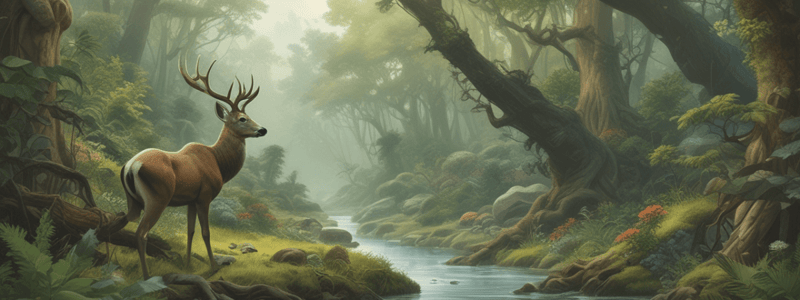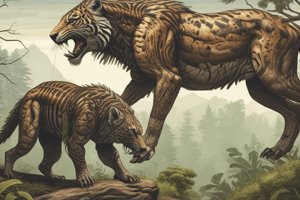Podcast
Questions and Answers
What is a habitat?
What is a habitat?
- The resources an organism needs to survive and reproduce
- The interactions between organisms
- The place an organism lives (correct)
- The physical and biological conditions required for an organism
Which of these accurately describes microhabitats?
Which of these accurately describes microhabitats?
- Areas far apart from each other
- Tiny parts of a habitat inhabited by small organisms (correct)
- Large areas where large organisms live
- Regions with no biological interactions
What is the focus of microbiomes?
What is the focus of microbiomes?
- Regions with no biological activity
- Communities of microorganisms that help each other out (correct)
- Communities of large animals
- Interactions between plants and animals
What does the term 'tolerance' refer to in an ecological context?
What does the term 'tolerance' refer to in an ecological context?
What is included in a species' niche?
What is included in a species' niche?
What is considered a resource for plants?
What is considered a resource for plants?
How do amphibians lose water?
How do amphibians lose water?
What is the Competitive Exclusion Principle?
What is the Competitive Exclusion Principle?
What happens during competition between species?
What happens during competition between species?
How does dividing resources affect a community?
How does dividing resources affect a community?
What is a key behavior of prey in response to their predators?
What is a key behavior of prey in response to their predators?
What impact do herbivores have on plant populations?
What impact do herbivores have on plant populations?
What is the significance of keystone species in an ecosystem?
What is the significance of keystone species in an ecosystem?
What type of relationship is characterized by one organism benefiting and not the other?
What type of relationship is characterized by one organism benefiting and not the other?
Which term describes a relationship where both parties benefit?
Which term describes a relationship where both parties benefit?
What is ecological succession?
What is ecological succession?
What triggers primary succession?
What triggers primary succession?
Who are the pioneer species?
Who are the pioneer species?
Why does succession happen?
Why does succession happen?
What distinguishes secondary succession from primary succession?
What distinguishes secondary succession from primary succession?
How does secondary succession differ in outcomes after natural vs. human-caused disturbances?
How does secondary succession differ in outcomes after natural vs. human-caused disturbances?
Which of the following statements best defines biodiversity?
Which of the following statements best defines biodiversity?
What are the three components included in biodiversity?
What are the three components included in biodiversity?
Which term describes the total of all genetically based variation in all organisms?
Which term describes the total of all genetically based variation in all organisms?
Which type of biodiversity refers to the variety of habitats, communities, and ecological processes in the biosphere?
Which type of biodiversity refers to the variety of habitats, communities, and ecological processes in the biosphere?
Which of the following is NOT a type of biodiversity?
Which of the following is NOT a type of biodiversity?
Which of the following is an example of an ecosystem service?
Which of the following is an example of an ecosystem service?
Which process helps in maintaining soil structure?
Which process helps in maintaining soil structure?
What is one benefit provided by ecosystems for weather-related events?
What is one benefit provided by ecosystems for weather-related events?
Which service is NOT considered an ecosystem service?
Which service is NOT considered an ecosystem service?
What role do ecosystems play in pest management?
What role do ecosystems play in pest management?
Study Notes
Habitat, Niche, and Species Interaction
- A habitat is the place where an organism lives.
- A resource is any necessity of life, such as sunlight, water, soil nutrients, nesting space, shelter, and food.
- An organism's niche is determined by its adaptation to its environment, including physical and biological aspects.
Physical Aspects of the Niche
- Organisms adapt to their environment, such as amphibians absorbing and losing water through their skin.
- Plants like cacti are adapted to heat and can store water.
Biological Aspects of the Niche
- The way an organism obtains food is a biological aspect of its niche.
- Each species has a unique niche, preying on different food sources.
Competition
- Competition occurs when more than one organism is after the same resource.
- Ecological disputes arise between organisms competing for resources.
Competitive Exclusion Principle
- No two species can occupy the same niche in the same habitat at the same time.
Dividing Resources
- Competition helps determine the numbers and kinds of species in a community and the niche each species occupies.
Predation and Herbivory
- Prey learn to avoid areas where predators are most active.
Succession
Primary and Secondary Succession
- Ecological succession is the process of a new community emerging after the destruction of an existing one.
- Primary succession occurs in barren areas, while secondary succession occurs in areas where an existing community has been disturbed.
- Pioneer species are the first to colonize barren areas.
Why Succession Happens
- Succession increases diversity and complexity in ecosystems.
Climax Communities
- Climax communities are the final stage of succession.
Succession After Natural Disturbances
- Secondary succession can reproduce the original climax community after natural disturbances.
Succession After Human-Caused Disturbances
- Secondary succession can take different paths and produce different communities after human-caused disturbances.
Biodiversity, Ecosystems, and Resilience
Types of Biodiversity
- Biodiversity is the total of all genetically based variation in all organisms.
- Biodiversity includes ecosystem diversity, species diversity, and genetic diversity.
Ecosystem Services and Biodiversity
- Ecosystem services include benefits like purifying water, buffering weather effects, pollinating, regulating pests, food production, nutrient cycling, and maintaining soil structure.
- Ecosystem services are essential for maintaining biodiversity.
Studying That Suits You
Use AI to generate personalized quizzes and flashcards to suit your learning preferences.
Description
This quiz covers the basics of habitats, niches, and species interaction in communities and ecosystems. Learn about the place an organism lives and how species interact with each other.




